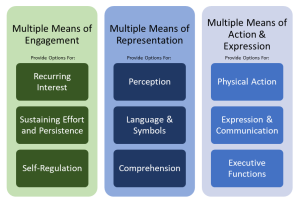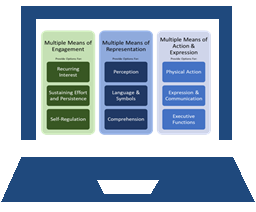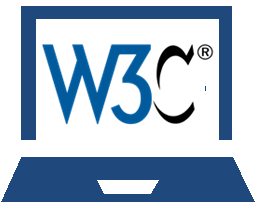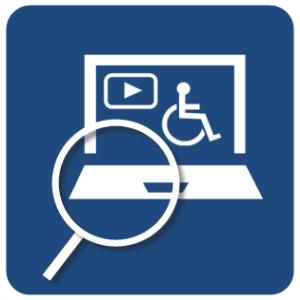Evaluating Course Accessibility In Post-Secondary
Caroline Nichol
Introduction
Many of the accessibility and inclusion barriers students face in higher education could be attributed to the legacy of discriminatory policies and practices, as well as the pervasive negative attitudes shown towards people who exhibit physical and cognitive differences outside normative social constructs. This ableist mindset has placed students with varying learning needs, physiological differences and socioeconomic barriers in a position of inferiority in academic settings. Human rights organizations and inclusion advocates have begun to rectify these issues by creating awareness and guidelines addressing the needs of students with physical, cognitive and social differences.
![]() Watch What is Ableism? (United Nations Human Rights, 2020) to learn more about ableism. (2:30 minutes)
Watch What is Ableism? (United Nations Human Rights, 2020) to learn more about ableism. (2:30 minutes)
To combat ableist ideologies in higher education, we must recognize the barriers people with disabilities and other intersecting marginalized identities face within our educational system. Barriers include issues associated with attitudinal (e.g. discriminatory behaviours, perceptions, and assumptions), organizational or systemic (e.g. unfair policies, procedures, and practices), architectural or physical (e.g. limitations to infrastructure design), information or communications (e.g., sensory or cognitive inconsiderations), and technological (e.g., lack of access and usability) barriers (Council of Ontario Universities, n.d.). Many of these barriers can be addressed through changes in existing policies and procedures in how schools operate and how the learning environment is conducted. However, many inclusive policies in Ontario schools failed to address systemic inequities in their districts and lacked substantial accountability measures to determine the effects of accessibility and inclusive policies for their communities (Rezai-Rashti et al., 2021).
The Ontario Human Rights Commission (OHRC) states that “inadequate training for educators” and “insufficient resources and supports in the classroom” are ongoing barriers for students in the educational system and stresses the importance of incorporating inclusive design strategies to combat those issues (OHRC, 2018). It is the role of the institution and educators to design and develop inclusive classrooms for their students. This can be done by (1) incorporating Universal Design for Learning (UDL) principles and Web Content Accessibility Guidelines (WCAG) practices, which can foster inclusive participation and academic success of all students, and (2) utilizing accessibility and inclusion evaluation instruments which can guide faculty in how they can better support a diverse group of learners, as well as stay accountable to diversity, equity and inclusion initiatives within an institution.
This analysis will outline some of the implementation challenges educators face in creating accessible learning environments and provide suggestions for a path forward.
Inclusive Design
![]() Watch Accessibility vs. Inclusive Design (NNgroup, 2024) to learn more about the differences. (4:38 minutes)
Watch Accessibility vs. Inclusive Design (NNgroup, 2024) to learn more about the differences. (4:38 minutes)
The goal of inclusive design is to remove obstacles that affect all students’ well-being and academic success. In a 2022 report, the Postsecondary Education Standards Development Committee highlights equity, diversity and inclusion as core principles guiding educational institutions to develop standards and practices that address the intersectional identities of students with disabilities and create a more accessible learning environment by 2025 (King’s Printer for Ontario, 2022). Accessibility and inclusion barriers are broad topics with many intersectional factors and potential solutions. Each post-secondary institution is a unique ecosystem comprised of administrators, stakeholders, support staff, educators, and students, and they all have a role to play in finding practical solutions that address these issues. As educators, we may not have control over the barriers our students face outside the classroom, but we do have a responsibility to remove them within the classroom. We do this by incorporating more inclusive theories and frameworks to redefine teaching practices that foster a more equitable learning environment to meet the needs of all learners, no matter their identities.
Frameworks such as Universal Design for Learning (UDL) and Web Content Accessibility Guidelines (WCAG) provide pedagogical and technical solutions for creating accessible learning environments and materials.
Universal Design for Learning (UDL)

CAST (2018) developed the UDL framework as a tool for providing all students with equal opportunities and access to learning. This framework outlines strategies for developing flexible curricula that provide multiple means of representation, expression, and engagement so that students may have fewer barriers to learning (OHRC, 2018). For example,
- Representation: Providing learning materials and learning opportunities in multiple formats (e.g., text, visual, audio) that use appropriate language (i.e., cultural significance) can tailor the learning experience to best meet the needs of individual students.
- Expression: Providing flexibility in how students demonstrate their learning (e.g. compatibility with assistive technology, variety of technologies, personal goal setting and autonomy) can further support knowledge acquisition.
- Engagement: Providing opportunities for students to relate to the learning experience (e.g., building community, motivation, relevance and reflection) can foster engagement and application to the lived experience of the students.
 To learn more about UDL, visit The UDL Guidelines on the CAST (2018) website.
To learn more about UDL, visit The UDL Guidelines on the CAST (2018) website.
Web Content Accessibility Guidelines (WCAG)
![]() The World Wide Web Consortium (W3C) (2021) developed the WCAG technical standards to create global guidelines that ensure digital content accessibility for all digital technology users. The standards are categorized by four principles: Perceivable, Operable, Understandable and Robust.
The World Wide Web Consortium (W3C) (2021) developed the WCAG technical standards to create global guidelines that ensure digital content accessibility for all digital technology users. The standards are categorized by four principles: Perceivable, Operable, Understandable and Robust.
- Perceivable: Information must be perceivable to all users and not limited to a specific sense (i.e., visual, auditory, kinesthetic).
- Operable: All users must be able to use and navigate content and not be limited to specific technologies.
- Understandable: Digital content must be consistent, reliable and clear.
- Robust: Digital content must be technically sound and compatible with other technologies.
 To learn more about WCAG, visit Resources for Trainers and Educators on the W3C website.
To learn more about WCAG, visit Resources for Trainers and Educators on the W3C website.
Challenges and Solutions
Educators are responsible for meeting students’ needs, so they may master the skills to be successful in their field of study and professional lives. However, how can this be accomplished if educators are not adequately supported and trained and also lack comprehensive guidelines for meeting inclusive standards? One significant shortcoming in our educational system is the lack of understanding of the accessibility and inclusive barriers students face and the lack of resources to provide practical solutions (Lomellini et al., 2022). Another corresponding shortcoming is the superficial nature of institutional policies and procedures, which do not comprehensively address accessibility and inclusion with plans of action and accountability measures (Fennelly-Atkinson et al., 2022; Pendergast, 2017; Rezai-Rashti et al., 2021). In conjunction, both shortcomings create a perpetual state of inaccessible and exclusionary practices that limit the academic success of many students.
To resolve these issues, the institution and its members should adopt a more critically inclusive praxis that acknowledges the existing gaps in inclusion and develop instruments to help facilitate inclusive learning experiences.
Evaluation Instruments
The Accessibility for Ontarians with Disabilities Act (AODA) advises that accessibility standards should be incorporated into colleges’ and universities’ quality assurance processes and program development projects (Kovac, 2023). These processes should invite feedback and perspectives from students and educators to continually assess the institution’s determination and work towards eliminating barriers in the learning environment. Currently, there are no specific or universally accepted evaluation instruments that encompass all accessibility and inclusion guidelines for online course development. Baldwin and Ching (2021) reviewed seven online course design evaluation instruments popular in North America. They found 14 accessibility themes that, at varying levels, address principles of UDL, WCAG and accessibility human rights laws. They published a comprehensive Online Course Accessibility Checklist resource (Baldwin & Ching, n.d.) for evaluating online course design projects. Both Baldwin and Ching (2021) and Fennelly-Atkinson et al. (2022) caution that current accessibility checklists and evaluation instruments may not encompass all accessibility issues and guidelines necessary for online course development, and they may not address the additional accessibility protocols institutions may have in place to supplement these evaluation instruments. Much work is needed to redevelop these instruments for the specific needs of each institution and their demographical needs, taking a proactive approach to addressing accessibility issues (Pendergast, 2017). Institutions should tailor their training and development strategies to the specific technologies they utilize in their organization and move towards more comprehensive inclusion policies and procedures.
 Review the list below for some of the commonly used technologies and their corresponding accessibility instruments used in postsecondary education.
Review the list below for some of the commonly used technologies and their corresponding accessibility instruments used in postsecondary education.
LMS Accessibility Checkers
- BrightSpace (D2L) (D2L, 2024)
- Blackboard ULTRA (Anthology, 2022)
- Canvas (Instructure) (Instructure, 2024)
Adobe
- Accessible PDF’s (Adobe, 2023)
Microsoft Office
- Office Accessibility Checker (Microsoft, 2024)
Inclusive Praxis
“Inclusive praxis refers to the process of using theory or experience-informed practices and reflection to intentionally design pedagogy and environments that enable full participation” (Warner et al., 2020, p. 244).
Educators and institutions may enhance their educational praxis by including Inclusive Design theories such as Culturally Responsive Teachings, Multimodal Literacies, and UDL (Watts-Taffe, 2022) in combination with technical guidelines such as WCAG to create a more holistic approach to teaching a diverse group of learners. This perspective looks at accessibility and inclusion issues from an Inclusive Design umbrella with supporting theories and practices to create positive social change.
Visit Ontario’s Ministry of Education website (King’s Printer for Ontario, 2024) to learn more about Culturally Responsive and Relevant Pedagogy (CRRP).
![]() To learn more about Multimodal Literacy, watch Developing a Critical Multimodal Literacies Pedagogical Framework | 2022 Literature Symposium from Foundation for Learning and Literacy (2022). (6:06 minutes)
To learn more about Multimodal Literacy, watch Developing a Critical Multimodal Literacies Pedagogical Framework | 2022 Literature Symposium from Foundation for Learning and Literacy (2022). (6:06 minutes)
Conclusion
As educators and institutions navigate the evolving accessibility and inclusion landscape, we must stay cognizant of the continuous efforts needed to dismantle educational barriers for students of marginalized groups. In this analysis, we discussed why diversity, equity, and inclusion are essential when discussing accessibility in the classroom. Ableism and accessibility is a social issue that affects not only students with disabilities but also other marginalized groups. We also discuss the gaps in effective evaluation instruments and the importance of institutions tailoring these instruments to their specific communities’ needs. Lastly, we discuss the importance of adopting a critically Inclusive praxis by combining inclusive pedagogies (Universal Design for Learning (UDL), Multimodal Literacies and Culturally Responsive Teachings) with technical accessibility standards (Web Content Accessibility Guidelines (WCAG)) to create a holistic and comprehensive approach to removing barriers for a diverse group of learners.
References
Adobe (2023, June 5). Create and verify PDF accessibility (Acrobat Pro). https://helpx.adobe.com/ca/acrobat/using/create-verify-pdf-accessibility.html
Anthology, Inc. (2022). Ultra Accessibility Checker (Powered by Ally). https://help.blackboard.com/Learn/Instructor/Ultra/Accessibility/Ultra_accessibility_checker
Baldwin, S. J., & Ching, Y. H. (2021). Accessibility in Online Courses: A Review of National and Statewide Evaluation Instruments. TechTrends, 65(5), 731–742. https://doi.org/10.1007/s11528-021-00624-6
Baldwin, S. J. & Ching, Y. H. (n.d.). Online Course Accessibility Checklist. https://sites.google.com/view/online-course-accessibility/home
CAST (2018). The UDL Guidelines. http://udlguidelines.cast.org
Council of Ontario Universities. (n.d.). Understanding Barriers to Accessibility: An Educator’s Perspective. Ontario Universities Accessible Campus. https://accessiblecampus.ca/tools-resources/educators-tool-kit/understanding-barriers-to-accessibility-an-educators-perspective/
D2L (2024). Improve Your Course with Brightspace Accessibility Checker. D2L Brightspace Community. https://community.d2l.com/brightspace/kb/articles/1382-improve-your-course-with-brightspace-accessibility-checker
Fennelly-Atkinson, R., LaPrairie, K. N., & Song, D. (2022). Identifying accessibility factors affecting learner inclusion in online university programs. Distance Education, 43(4), 556–573. https://doi.org/10.1080/01587919.2022.2141607
Instructure (2024). How do I use the Accessibility Checker in the Rich Content Editor as an instructor? Instructure Community. https://community.canvaslms.com/t5/Instructor-Guide/How-do-I-use-the-Accessibility-Checker-in-the-Rich-Content/ta-p/820
King’s Printer for Ontario (2024). Considerations for program planning. Curriculum and Resources. https://www.dcp.edu.gov.on.ca/en/program-planning/considerations-for-program-planning/human-rights-equity-and-inclusive-education
King’s Printer for Ontario (2022). Development of proposed postsecondary education standards — final recommendations report 2022. https://www.ontario.ca/page/development-proposed-postsecondary-education-standards-final-recommendations-report-2022
Kovac, L. (2023). Accessibility Standards for Teaching and Learning at College and University. Accessibility for Ontarians with Disabilities Act. https://www.aoda.ca/accessibility-standards-for-teaching-and-learning-at-college-and-university/
Lomellini, A., Lowenthal, P. R., Snelson, C., & Trespalacios, J. H. (2022). Higher education leaders’ perspectives of accessible and inclusive online learning. Distance Education, 43(4), 574–595. https://doi.org/10.1080/01587919.2022.2141608
Microsoft (2024). Check accessibility while you work in Office apps. Microsoft Support. https://support.microsoft.com/en-us/office/check-accessibility-while-you-work-in-office-apps-ae9e8ea7-1f22-41af-ad04-cc2919daebae
NNGroup (2023, October 4). Accessibility vs. Inclusive Design. [Video]. https://youtu.be/hE83Qn-PTGA
Ontario Human Rights Commission [OHRC]. (2018). Policy on accessible education for students with disabilities. Ontario Human Rights Commission. https://www.ohrc.on.ca/en/policy-accessible-education-students-disabilities
Pendergast, M. O. (2017). Evaluating the Accessibility of Online University Education. International Journal of Online Pedagogy and Course Design, 7(1), 1–14. https://doi.org/10.4018/IJOPCD.2017010101
Rezai -Rashti, G., Zhang, B., Abdmolaei, S., & Segeren, A. (2021). A critical policy analysis of the Ontario equity and inclusive strategy: The dynamics of non-performativity. Journal of Higher Education Policy and Leadership Studies, 2(4), 7–25. https://dx.doi.org/10.52547/johepal.2.4.7
United Nations Human Rights (2020, December 18). What is ableism? [Video]. https://vimeo.com/492480733
Warner, R. P., Martin, B., & Szolosi, A. M. (2020). Exploring the Inclusive Praxis of Outward Bound Instructors. Education Sciences, 10(9), 241–256. https://doi.org/10.3390/educsci10090241
Watts‐Taffe, S. (2022). Multimodal Literacies: Fertile Ground for Equity, Inclusion, and Connection. The Reading Teacher, 75(5), 603–609. https://doi.org/10.1002/trtr.2080
WCAG. (2021). WCAG 101: Understanding the Web Content Accessibility Guidelines. WCAG. https://wcag.com/resource/what-is-wcag/
